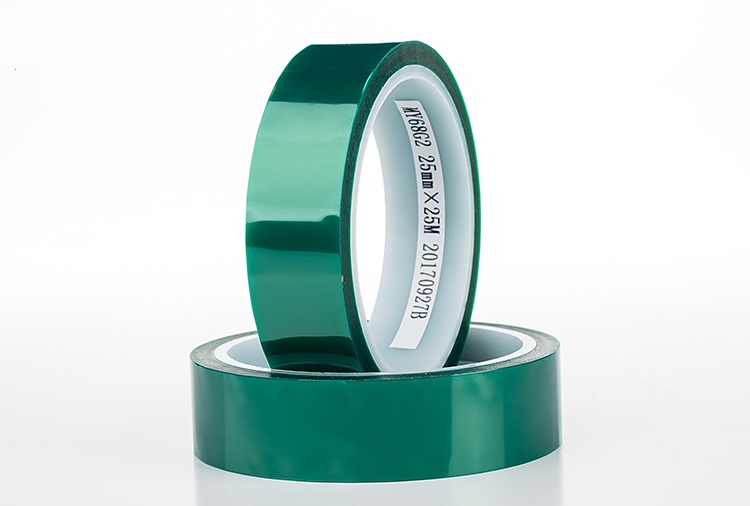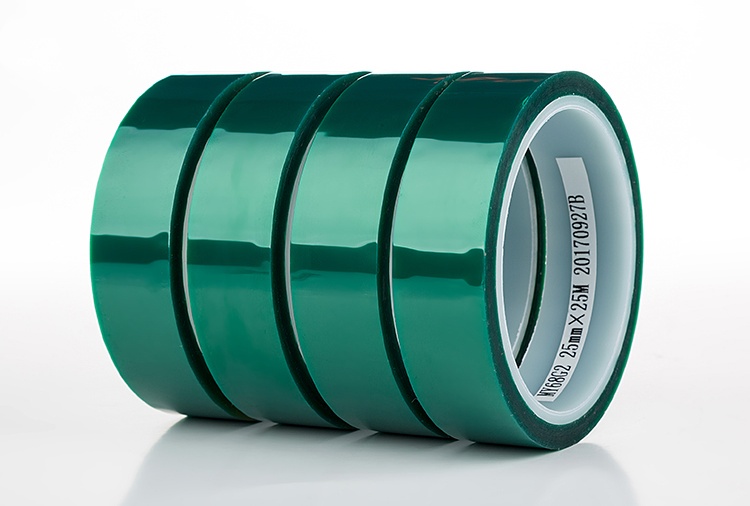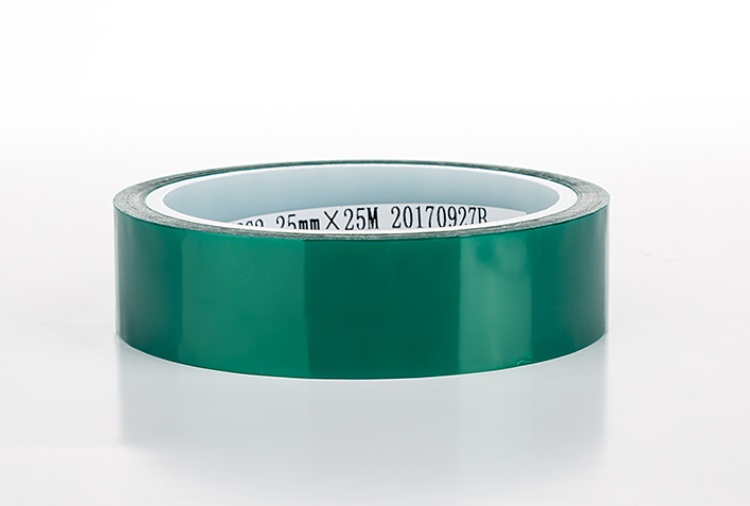



Green high-temperature tape
High-temperature masking tape is mainly used in the electronics industry, with temperature resistance typically ranging from 120℃ to 260℃. It is commonly applied for masking in electroplating, powder coating, and painting processes, as well as for fixation in the manufacturing of electronic components, and masking of printed circuit boards (PCBs) during high-temperature processing. Types of high-temperature masking tape include polyimide high-temperature tape, high-temperature masking paper tape, and polyester green high-temperature tape, among others.
Detailed description
High-temperature green tape is made by single-sided coating of high-performance silicone pressure-sensitive adhesive on a base material of PET polyester film. It features excellent high temperature resistance, cold resistance, high adhesion, no residual adhesive after re-peeling, and solvent resistance. It is mainly used for masking protection of working surfaces in high-temperature environments, as well as for applications such as electroplating, ultra-high temperature painting, powder spraying, splicing of silicone release films for leather production, and use on terminal electrodes of chip components.
Related Specifications
| Series | Product code | Adhesive | Material | Standard size) | Tack (N) | Adhesion (N/25mm) | Tensile strength (N/25mm) | Temperature resistance (℃) | ||
| Thickness (mm) | Width (mm) | Long (m) | ||||||||
| Green high-temperature tape | MY35G | Silicone | PET | 0.05 | 1000 | 33 | 1↑ | 5↑ | 70↑ | 200 |
| Green high-temperature tape | MY68G | Silicone | PET | 0.06 | 1000 | 33 | 2↑ | 7↑ | 40↑ | 200 |
FAQ
Lens Protection Tape Series
Specialized for encapsulating resin eyeglass lenses during high-temperature curing processes. Key features include high transparency, residue-free removal, and heat resistance up to 130°C (e.g., JT8860 for blue-light-blocking lenses)
Lithium Battery Tape Series
Includes termination tapes (for electrode insulation), PACK tapes (bundle fixation), and tab lead tapes (welding point protection). Made from PI/PET films with electrolytic corrosion resistance, critical for cylindrical/pouch cell safety
LED Encapsulation High-Temperature Tape Series
Designed for LED epoxy resin filling and curing (e.g., MY68C transparent tape for digital tubes). Withstands 150–180°C, prevents overflow, and leaves no residue after peeling
Connector Tapes Series
Insulating tapes for electronic connectors and terminals, ensuring stability in soldering (reflow peak: 260–300°C). Commonly uses PI films for dielectric strength
Insulation & Fixation Tapes Series
Glass fiber-reinforced tapes for coil binding in motors/transformers, offering mechanical strength and flame retardancy (180–220°C continuous use)
High-Temperature Double-Sided Tape Series
Features acrylic/silicone adhesives on PI/PET bases. Used for bonding heat sinks, battery modules, and composite materials, withstanding 120–180°C long-term
Masking Tapes Series
Includes high-temp masking paper and PET green tapes for spray painting, powder coating, and PCB gold finger protection. Resists solvents, leaves sharp edges, and operates at 150–230°C
Teflon Tape Series
PTFE-based tapes with ultra-low friction and 260–300°C continuous resistance. Applied in non-stick industrial conveyors, food packaging seals, and chemical equipment lining
Yes, we can develop tailored solutions based on your sketches or ideas to address your business challenges.
The Company serves all customer segments, offering tailored solutions for large enterprises, small businesses, and individual users.
The term “green high-temperature tape” most often refers to a high-temperature masking tape made from a polyester (PET) film base coated with a silicone pressure-sensitive adhesive. Because its classic color is green (or emerald green), it’s named “green high-temperature tape.”
The core properties of Green High-Temperature Tape can be summarized in the following four key points. These properties work together to make it irreplaceable in industrial applications:
1. Excellent High-Temperature Resistance
This is its most fundamental and core characteristic.
Specification: It can typically withstand high temperatures ranging from 180°C to 220°C (approximately 400°F), and even higher for short periods of time.
Why it’s so important: Industrial spray coating, paint baking, and wave soldering all involve high-temperature baking or soldering. Conventional tapes melt, shrink, become brittle, or lose their adhesive properties under high temperatures. Green High-Temperature Tape, however, maintains its physical form and adhesion in these environments, ensuring the integrity of the masking effect.
2. Clean Removal, No Residue
This characteristic, equally important as high-temperature resistance, underlies its value as a professional “masking” tape. Specific Features: After undergoing a high-temperature process, the tape can be removed cleanly and easily from the workpiece surface, leaving no sticky residue and without damaging the masked surface.
Why It Matters: Industrial finished products require extremely high standards for appearance and surface cleanliness. If the tape leaves adhesive residue, additional cleaning steps are required, which not only increases cost and time, but also potentially uses chemical solvents to damage the product surface. Clean removal ensures production efficiency and product quality.
3. Excellent Chemical Resistance
This is the foundation for its application in chemical treatment environments such as electroplating and anodizing.
Specific Features: It resists corrosion and penetration by most industrial solvents, acids, alkalis, cleaning agents, and plating solutions.
Why It Matters: During surface treatments such as anodizing and electroplating, the tape must be immersed in corrosive chemical baths. If the tape is not corrosion-resistant, it will dissolve or break down, allowing the chemical liquid to penetrate the protected area and render the masking ineffective.
4. Good Physical Properties
This ensures the tape’s reliability and ease of use in real-world operations.
Specific Features:
High Strength: The PET substrate has high tensile strength, making it resistant to tearing or puncturing.
Good Conformability: The tape’s flexibility allows it to adhere well to various irregular or curved surfaces, achieving precise masking.
Dimensional Stability: It resists shrinking or deformation at high temperatures, ensuring precise masking edges.
Why It’s Important: When masking complex shapes, tape that is too hard or too brittle will not form an effective seal, potentially allowing paint or chemicals to leak through. High strength also ensures that the tape will not break into pieces during removal.
The material composition of green high-temperature tape is very classic and focused, essentially a combination of two core materials. When we talk about “common materials,” we’re primarily discussing the specific selection and properties of these two components.
1. Backing Material: Polyester Film (PET)
This is the “skeleton” of the tape and what gives it its green color.
Material Name: Polyester, chemically known as polyethylene terephthalate, abbreviated as PET. Common mineral water bottles are made of this material, but the PET film used for tape undergoes a more sophisticated biaxial stretching process, resulting in superior performance.
Why Choose PET?
Excellent Temperature Resistance: PET has a melting point above 250°C. While it cannot withstand long-term operation at this point, it can maintain its shape in temperatures below 220°C and does not melt or shrink as easily as common plastics such as PE and PVC.
High Mechanical Strength: It is extremely tough and has strong tensile, tear, and puncture resistance. This ensures the tape is not prone to breakage during application and removal.
Excellent Dimensional Stability: Its minimal expansion and contraction during temperature fluctuations ensures neat and precise masking edges.
Chemical Resistance: Resistant to most acids, alkalis, and organic solvents.
Excellent Insulation: PET itself is an excellent insulating material and is therefore commonly used in electrical insulation applications.
Thus, when referring to the backing material of green high-temperature tape, PET film is more than 99% of the time.
2. Adhesive: Silicone Pressure-Sensitive Adhesive
This is a key component that determines the tape’s adhesion, temperature resistance, and “no residue” properties.
Material Name: Silicone Adhesive.
Why Choose Silicone?
Excellent High-Temperature Resistance: This is silicone’s most significant advantage. Its chemical bonds (Si-O) are extremely stable, allowing it to maintain its adhesive properties at temperatures up to 260°C or even 300°C, unlike rubber or acrylic adhesives, which tend to decompose, flow, or carbonize at high temperatures.
Clean Removal: Silicone adhesives have high cohesion and moderate adhesion to most surfaces. Even after high-temperature baking, their chemical structure remains stable, allowing them to be peeled cleanly from surfaces without chemical bonding or degradation, leaving no residue.
Strong Chemical Resistance: They also offer excellent resistance to chemicals.
Excellent Weather Resistance: They offer superior UV and aging resistance compared to other adhesives.
Green high-temperature tape (PET silicone tape), with its core properties of high-temperature resistance, no residue, and chemical resistance, is primarily used in the following key industrial manufacturing processes, all for precision masking and protection in high-temperature environments.
The following are its main and most common applications:
1. Surface Coating & Treatment
This is the largest application area for green high-temperature tape, used in almost all coating processes requiring high-temperature curing.
Powder Coating: During electrostatic powder coating of workpieces such as computer cases, cabinets, automobile wheels, bicycle frames, and metal furniture, tape is used to mask screw holes, bearing contact surfaces, logo areas, and other areas that do not need to be coated. After coating, the workpiece is placed in an oven at approximately 200°C for curing. The tape protects the masked areas during this process and is removed after curing.
Electrophoretic Coating: Similar to powder coating, it is used for masking and protection during electrophoretic coating of automotive parts and hardware. High-Temperature Painting: Used in applications where high-temperature baking is required after spraying liquid paint, such as automotive manufacturing and repair, and mechanical equipment housings.
2. Electronics Manufacturing
It is an indispensable protective material during the assembly and manufacturing of printed circuit boards (PCBs).
Wave Soldering: When soldering through-hole components to a PCB, green high-temperature tape is applied to the non-soldering surface of the PCB to protect areas such as gold fingers, screw holes, and surface-mount components from contamination by the high-temperature solder. Wave soldering temperatures typically reach around 260°C, and the tape must withstand the sudden high temperature shock.
Reflow Soldering: In surface mount technology (SMT), it is sometimes used to temporarily secure components or mask specific areas to prevent them from shifting or being affected by the reflow oven.
Conformal Coating for PCBs: This tape is used to protect areas of PCBs that do not require coating, such as connectors, sockets, and test points, when applying conformal coating (moisture-proof, salt spray-proof, and mildew-proof) to PCBs.
3. Anodizing & Plating: Due to its excellent chemical resistance, it is widely used in metal surface chemical treatment processes.
Anodizing: When anodizing aluminum or its alloys to enhance hardness and corrosion resistance, the tape is used to mask areas that do not need to be oxidized. It protects against the acidic electrolyte in the oxidation tank.
Plating: During spot electroplating, it is used as a masking tape to ensure that only specific areas are plated with metal.
4. Other Industrial Applications: Composite Bonding: In the aerospace and automotive industries, the manufacture of glass fiber or carbon fiber components sometimes requires high-temperature and high-pressure molding. Green high-temperature tape can be used for temporary fixation, mold sealing, or as a mold release aid.
High-Temperature Splicing: In some roll-to-roll production lines that require high-temperature ovens (such as film and paper coating), this tape can be used to connect the ends of two rolls of material, allowing them to pass smoothly through the high-temperature unit without interrupting production.
3D Printing: In some 3D printers with heated beds, users apply this tape to the build platform as the base surface for printed models because it is durable, smooth, and helps the model adhere.
The company mainly provides the following types of green high-temperature tapes: MY35G, MY68G, MY57G, and MY58G. The base material is PET and the adhesive is silicone. Different thicknesses are available in different models.
